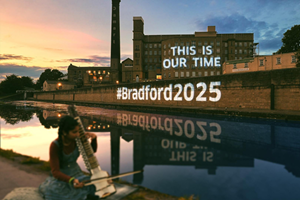When you’re marketing a place rather than a product, how do you tell its story authentically?


That was the question at the heart of a recent CIM Yorkshire webinar, “How to Market a City – with Strategy and Storytelling.”
The session brought together marketing leaders from Hull 2017 and Bradford 2025, two UK Cities of Culture that have redefined what place-branding really means.
Hosted by Rachael Simpson, Vice Chair of Events for CIM Yorkshire, the discussion featured Anthony Yates (Destination Manager, Visit Hull and East Yorkshire), Rhiannon Hannon (Director of Creative Engagement, Bradford 2025), and Janina Mundy (Director of Audiences, Bradford 2025).
Hull: From Doubt to Pride
When Hull first secured City of Culture status, few residents fully understood what it meant.
“We had to win hearts and minds first,” said Anthony Yates. “The campaign wasn’t for the council. It was for the city.”
Anthony’s plan focused on changing perceptions through collaboration. That meant working with cultural communities, local government and national stakeholders, and developing a flexible three-year strategy. “It had to be real, it had to be honest,” he explained. “The brand was always there; we just elevated it.”
One unforgettable moment came in January 2017 when Made in Hull, a spectacular light show, illuminated Queen Victoria Square. The production told the story of Hull through its maritime heritage, wartime courage and community pride.
“There wasn’t a dry eye,” Anthony recalled. “That week wiped away the apathy. People saw themselves in the story.”
The legacy of that year remains visible today. Hull has seen sustained investment in its city centre, new hotels and cultural venues, and a revived confidence across its communities.
“Legacy manifests in many forms, but confidence is key,” said Anthony. “The city now believes in itself, and others do too.”
Bradford: A People-Powered Story
Bradford’s cultural moment builds on that same principle of authenticity. As Janina Mundy described, “We didn’t want to put anything on Bradford that wasn’t already there. It’s about shouting proudly about who we are.”
The city is one of the youngest and most diverse in the UK, with 25 per cent of residents under 18, 33 per cent identifying as non-White British and over 150 languages spoken. Bradford 2025 aims to reflect that vibrancy through storytelling at scale.
Rhiannon Hannon explained how the team’s Story of Change strategy ensures culture is accessible across all districts:
“We’re broadening what culture means. It’s not just theatre or art galleries. It’s food, faith, family and fun. Culture should belong to everyone.”
To achieve this, the Bradford 2025 team has built deep partnerships across the district. From schools and libraries to NHS trusts and local hubs, every partner helps make culture visible and relevant. “Our main stakeholder is the people of Bradford,” Rhiannon said. “They’re the ones shaping it.”
Momentum, Milestones and Meaning
Bradford’s opening event drew 20,000 people and set the tone for a year of pride and participation. “When you’re in it, you’re so busy you forget to stop and see what’s happening,” Janina reflected. “But you can feel the shift. There’s less negativity in the media and more people proudly standing up for Bradford.”
Recent highlights include collaborations with the Royal Ballet and Opera North, increased LNER train services, and The Beacon, a travelling pop-up venue that brought performances and community events to local parks. As Rhiannon put it, “This is about building a district-wide City of Culture, not just the city centre.”
Lessons for Marketers
Both Hull and Bradford demonstrate that successful place marketing is built on trust, storytelling and self-belief. It takes clarity of message, community partnerships and a willingness to let people own their narrative.
“Be realistic about scale, but aim for inspiration,” said Anthony. “You’re not just marketing a city. You’re building its confidence.”
Or, in the words of Bradford’s team, about Bradford:
“It’s not shiny. It’s real. It’s radical. It’s proud. And that’s what makes it beautiful.”
Key Takeaways
- Culture as Catalyst. Both Hull and Bradford used the City of Culture title to drive regeneration, pride, and investment. Hull saw physical transformation, while Bradford focused on community-led programming and youth engagement.
- Storytelling at Scale. Marketing a city requires balancing hyper-local narratives with national and international messaging. Bradford’s approach was “people-powered,” while Hull focused on shifting perceptions through immersive storytelling.
- Legacy Matters. Hull’s volunteer programme continues to thrive post-2017. Bradford is building long-term partnerships with schools, community hubs, and cultural organisations to ensure lasting impact beyond 2025.
- Inclusive Engagement. Bradford’s programming includes multilingual events, rural outreach, and a network of local producers and “networkers” to ensure representation and accessibility.
- Branding with Purpose. Bradford’s brand colours—green, amber, and pink—reflect its landscape, architecture, and radical spirit. The brand was co-created with communities and remains adaptable and authentic.

